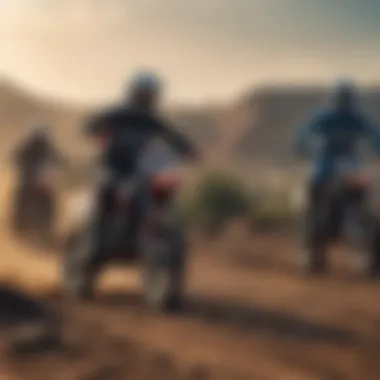The Dynamics of Motocross: Insights from a Biker


Intro
Motocross embodies a unique blend of skill, courage, and relentless pursuit of adrenaline. This sport does not merely involve riding a motorcycle on rugged terrains; it represents a lifestyle that thrives on the thrill of competition and camaraderie among riders. Understanding the dynamics of motocross requires an exploration into its defining elements, including equipment, training, safety, and the community that fosters this exhilarating pursuit.
As motocross racing evolved, so did the gear, skills, and safety practices that define today’s sport. This comprehensive guide aims to delve into each facet from a biker's perspective, providing an insider view on the essentials that contribute to the experience of both novice and seasoned riders. Through each section, we will uncover the intricacies of this demanding sport, highlighting the nuances that can make or break a rider's journey.
Equipment and Gear
In motocross, the right equipment can significantly influence performance and safety. Essential gear includes helmets, gloves, boots, and protective wear, all designed to shield riders from the harsh realities of the sport.
Overview of Essential Gear
- Helmets: A quality helmet is non-negotiable, with brands like Bell and Shoei leading the way in safety and comfort. Riders should look for snug fits, effective ventilation, and advanced safety ratings.
- Gloves: They provide grip and control on the motorcycle. Brands such as Fox and Oakley offer gloves that combine durability with comfort, ensuring riders maintain a solid grip on the handlebars.
- Boots: Specialized motocross boots protect the feet and ankles and enhance a rider's control over their machine. Brands like Alpinestars and Gaerne offer robust options that prioritize both safety and performance.
Detailed Descriptions of Top Brands
When selecting gear, consider investing in renowned brands known for quality. For example:
- Bell Helmets: Highly regarded for their safety features, with a focus on impact resistance.
- Fox Racing: Known for their motocross apparel, they create gear that caters to visceral needs of individual riders.
Tips on Maintenance and Upgrades
Regular maintenance of gear is crucial. Always check your helmet for signs of wear and tear, and replace it every few years or after a significant impact. Similarly, clean and inspect your boots and gloves frequently. Stay informed about new advancements in materials and technology, such as moisture-wicking fabrics that can make a difference in comfort during long rides.
Techniques and Training
Mastery in motocross hinges on continuous training and refining techniques. The following methods can elevate performance.
Breakdown of Skills and Techniques
- Cornering: Efficient cornering can differentiate a skilled rider from an amateur. Practice leaning into turns and maintaining momentum.
- Jumps: Learning how to approach and land jumps can prevent injury and improve speed significantly.
Training Exercises
To enhance strength, agility, and endurance:
- Cardio Exercises: Cycling and running improve stamina, vital for lengthy races.
- Strength Training: Focus on core workouts to better control the bike during rigorous maneuvers.
Insights from Professionals
Many professional motocross athletes emphasize the importance of mental training alongside physical preparation. Visualization techniques can aid in mentally preparing for challenging courses and scenarios.
Safety and Risk Management
Safety should be a priority in motocross due to inherent risks.
Importance of Safety Protocols
Implementing safety measures reduces the chance of accidents. Always wear appropriate protective gear, be familiar with the courses, and maintain your motorcycle properly.
Common Risks and Hazards
- Falls: High speeds can lead to severe injuries during falls.
- Collisions: Riders must be aware of others on the track to prevent crashes.
Strategies for Risk Mitigation
- Take short training sessions that allow for recovery and reduce fatigue during practice.
- Regular check-ups of equipment can help catch potential failures before they happen.
Events and Competitions
Competitions are where motocross truly shines, showcasing skills on various terrains.
Upcoming Competitions
Stay informed about events through platforms like Reddit and local motocross associations. Each season brings exciting new competitions, pushing riders to elevate their skills.
Profiles of Top Competitors
Following notable competitors provides insights into their training regimes and philosophies. Riders often share tips and experiences through social media.
Recent Highlights
Coverage of recent events reveals trends in competitive riding and emerging talents in motocross.
Lifestyle and Community
The motocross community is at the heart of the sport.
Lifestyle Aspects
Engaging in motocross often means adopting a particular lifestyle. Riders tend to prioritize fitness and mental well-being to perform at their best.


Balancing Sports and Wellness
Participating actively in the community helps foster connections and support systems among riders, offering motivation and camaraderie. Integrating healthy habits can lead to a more fulfilling experience in the sport.
Understanding Motocross
Understanding motocross is crucial for anyone interested in this exhilarating sport. It provides insights not only into the mechanics of riding but also into the culture that surrounds it. Motocross is more than just a hobby; it is a combination of skill, physical fitness, and a deep connection to the community. This section elucidates the fundamental aspects of motocross and lays the groundwork for further exploration of the sport.
Definition and Origins
Motocross can be defined as a form of off-road motorcycle racing held on enclosed off-road circuits. This sport has its roots in Europe, particularly in England, where it began in the early 20th century as a way to test the durability of motorbikes in rugged terrains. The name itself is derived from the mix of "motorcycle" and "cross-country." Over time, motocross has evolved into a highly competitive sport with organized events and professional racers around the world.
In its formative years, motocross was characterized by a focus on endurance. Riders would often participate in events that lasted several hours, tackling various natural obstacles. As the sport matured, it began to embrace a more structured format, including shorter races and purpose-built tracks featuring jumps and turns. The International Motorcycling Federation (FIM) played a significant role in standardizing rules and promoting motocross on a global scale.
Key Characteristics
Motocross has distinct characteristics that set it apart from other forms of motorcycle racing. Here are some key elements:
- Race Tracks: Motocross tracks are engineered for high-speed racing. They comprise a mix of ramps, berms, and different terrains, making them challenging and rewarding. The design emphasizes technical skills and risks, testing riders’ abilities.
- Variety of Events: There are different types of motocross events, such as supercross and freestyle motocross, each with unique rules and formats, adding diversity to the sport.
- Diverse Skill Levels: The sport welcomes riders of all skill levels, from amateur enthusiasts to seasoned professionals. This inclusivity fosters a supportive community.
- Seasoned Athletes: Competitors often partake in rigorous training regimens, focusing on physical conditioning, technical skills, and mental preparation. Riders need agility, strength, and endurance to navigate the demands of the sport.
- Community and Culture: Beyond the racing, the motocross community is tight-knit and passionate. Events and gatherings foster camaraderie among enthusiasts, promoting shared experiences and friendships.
"Understanding the sport is the first step to truly enjoying the ride."
In summary, understanding motocross involves recognizing its history, characteristics, and the community it nurtures. This lays the foundation for deeper insights into the mechanics of riding, the equipment used, and the psychological aspects that accompany this thrilling sport.
The Motocross Bike
The motocross bike serves as the fundamental element in the sport of motocross. It is not just a mode of transport; it embodies the spirit of the sport. Understanding the different types of motocross bikes, their essential components, and customization options allows riders to enhance their performance and riding experience.
Types of Motocross Bikes
Motocross bikes are specifically designed to handle rugged terrain and competitive racing scenarios. Key types include:
- Two-stroke bikes: Known for their lightweight nature, these bikes deliver high power and a simple engine design. They offer quicker acceleration but may require more maintenance.
- Four-stroke bikes: These bikes tend to provide better torque and are generally more durable. They are heavier but offer consistent power for longer race durations.
Choosing the right type of bike depends on the rider's skill, preferences, and racing style.
Essential Components
Engine specifications
The engine is crucial to a motocross bike's performance. Two-stroke engines provide a lighter weight and rapid throttle response. In contrast, four-stroke engines offer smoother power delivery, which is beneficial for precision control during races. The displacement size is also vital—bikes with larger displacements typically deliver more power but can also weigh more.
Key characteristics of engine specifications include:
- Power-to-weight ratio: This determines a bike's acceleration. A higher ratio suggests better performance.
- Maintenance frequency: Two-stroke engines often require more frequent maintenance, influencing rider decisions based on commitment and experience.
Suspension systems
The suspension plays a vital role in a motocross bike's handling and rider comfort. Well-tuned suspension systems absorb bumps and help riders maintain control over uneven terrain.
Components of a good suspension include:
- Front forks: These help in stabilizing the bike during jumps and turns.
- Rear shock: This absorbs impacts and balances the ride.
The uniqueness of a suspension system lies in its ability to be tailored to individual rider needs, which can greatly enhance performance.
Tires and grips
Tires directly influence traction and handling. Different terrain requires suitable tires—soft terrain tires with deeper treads offer grip, while hard terrain tires provide stability and speed.
The essential aspects of tires and grips include:
- Tread pattern: This affects how the bike interacts with the ground. Deeper grooves work well in soft mud, while slick patterns are better for hard surfaces.
- Grip levels: Higher grip can improve control but may lead to faster wear and tear.
Customization and Upgrades
Customization is significant for any rider looking to enhance performance. Riders often tweak various elements of their bike, from adjusting the suspension settings to upgrading the exhaust system. These modifications can lead to improved handling, increased speed, and ultimately a better racing experience.
Adjustments can include:
- Handlebar height and width: Changing these can improve comfort and control.
- Footpegs: Upgrading footpegs enhances grip and support, which can be crucial during intense races.
Motocross Gear and Safety
Motocross biking presents an exhilarating blend of speed, skill, and uncontrolled terrain. The right gear and effective safety measures prove essential to not only enhance performance but also to minimize risks associated with the sport. Riders need to prioritize their safety and well-being while joyfully navigating the complex trails and ramps. Investing in quality motocross gear significantly influences a biker's experience and longevity in this demanding sport.
Protective Equipment Overview
Helmets
Helmets serve as one of the most critical elements of protective gear in motocross. Their primary role is to protect the rider's head during potential impacts. A quality helmet cushions the skull and absorbs shock, reducing the risk of serious head injuries. The key characteristic of motocross helmets is their lightweight design combined with superior shock absorption. This design offers comfort without compromising safety, making them a popular choice among enthusiasts. Furthermore, many modern helmets come equipped with ventilation systems to increase airflow and enhance comfort during intense rides. However, one must ensure the helmet fits properly, as an ill-fitted helmet may not provide adequate protection.
Body armor


Body armor is designed to safeguard vital areas, such as the back, chest, and shoulders, from potential injuries sustained during falls or collisions. The primary aspect of body armor is its ability to disperse the force from impacts, thus minimizing trauma. This gear stands out because of its specialized padding and protective plates, which are built to withstand the robust demands of motocross. Riders often opt for body armor because it offers a balance between protection and mobility. Some advanced options come with moisture-wicking technology to keep riders dry. Yet, some armor may restrict full range of motion, which is an important consideration when selecting gear.
Gloves and boots
Gloves and boots contribute significantly to the overall safety and performance of motocross riders. Gloves provide crucial grip on the handlebars, which is vital in maintaining control during fast maneuvers. The key characteristic of motocross gloves includes their reinforced palms and flexible materials, designed for comfort and durability. Many riders favor gloves with added padding to enhance grip and reduce vibrations, though potential trade-offs may include less dexterity than lighter options. Boots, on the other hand, are instrumental in protecting the feet and ankles. They are designed with sturdy materials that resist abrasion and offer support. A unique feature of motocross boots is their ability to keep water and mud out while maintaining breathability. Properly fitted boots are essential for control and balance, but overly rigid designs may lead to discomfort during extended riding.
Importance of Safety Gear
The importance of safety gear in motocross cannot be overstated. As riders navigate challenging courses at high speeds, the risk of accidents rises significantly. Wearing the appropriate gear not only safeguards against injuries but also instills confidence in the rider. This confidence can enhance performance and allow bikers to push their limits while knowing they are protected. Moreover, consistent use of safety gear sets a standard within the motocross community, promoting a culture of safety that helps educate newer riders about proper practices.
Training for Motocross
Training for motocross is a critical aspect that distinguishes skilled riders from amateurs. Proper training enhances performance, reduces injury risk, and improves overall enjoyment of the sport. Riders must focus on various elements, including physical conditioning, riding techniques, and mental preparation, to excel in this demanding environment.
Physical Conditioning
Physical conditioning is the backbone of motocross training. It involves developing the body's strength, endurance, and flexibility needed to handle the physical demands motocross presents.
Endurance training
Endurance training is essential in motocross as it allows riders to maintain energy throughout long races and intense practice sessions. A key characteristic of this training is its ability to improve cardiovascular fitness. By engaging in activities like running or cycling, riders can build stamina crucial for lasting over multiple laps. The unique feature of endurance training lies in its focus on sustained activity, which helps to delay fatigue during races. Advantages include enhanced performance and quicker recovery times, while disadvantages might include placing less emphasis on strength if not balanced properly.
Strength training
Strength training is another significant component of motocross training. This type of training aids in building muscle mass and increasing power output, essential for maneuvering heavy bikes. A core characteristic is the emphasis on compound movements like squats and deadlifts, which target multiple muscle groups. Many riders find strength training beneficial as it translates directly into better control of the bike and improved overall riding ability. However, if not approached carefully, it can lead to overtraining and injuries, making environment change key for progress.
Flexibility exercises
Flexibility exercises play a crucial role in preventing injuries in motocross riders. These exercises help in enhancing the range of motion, allowing for better stability on the bike. A notable characteristic of flexibility training is its role in alleviating muscle tightness. Activities such as yoga or stretching routines enhance recovery and performance by promoting blood circulation. The advantages of flexibility training include maintaining joint health and reducing the risk of strains; however, these exercises may sometimes be neglected in favor of strength or endurance training.
Riding Techniques
Riding techniques involve mastering various skills and maneuvers necessary for successful motocross performance. This area includes cornering, jumping, and navigating obstacles. Proper technique can greatly improve lap times, reduce energy expenditure, and enhance safety, making it a vital part of any training regimen.
Mental Preparation
Mental preparation is as crucial as physical training in motocross. Riders must develop focus and manage stress effectively to compete at high levels.
Focus techniques
Focus techniques help riders concentrate on their performance and minimize distractions during races. A key characteristic of these methods includes visualization exercises, where riders mentally rehearse their runs. This approach is popular in the motocross community because it fosters confidence and enhances reaction times. The unique aspect of focus techniques is their ability to train the mind in addition to the body, providing a well-rounded preparation strategy. Disadvantages might include the time commitment required to practice effectively.
Stress management
Stress management is vital for motocross riders, particularly during competitions. It encompasses strategies to reduce anxiety and maintain a balanced mindset. A critical aspect of stress management includes breathing exercises or mindfulness practices that encourage relaxation. This is beneficial because it can lead to improved decision-making during races, potentially impacting performance positively. However, if not practiced consistently, the benefits might be short-lived.
"Training is not just physical; it encompasses all aspects of performance, especially in extreme sports like motocross."
In summary, comprehensive training in motocross requires an intricate blend of physical conditioning, skill development, and mental preparation. Each component feeds into the other, creating a holistic approach that prepares enthusiasts for the rigors of the sport.
The Competitive Scene
The competitive scene of motocross serves as the heartbeat of the sport. It is where passion meets skill and commitment. Engaging in competitions allows riders to test their abilities, push boundaries, and ultimately grow within the sport. Understanding the nuances of competitions and events is critical for any aspiring motocross rider. It forms a vital part of the motocross experience. Riders gain exposure to various racing formats and popular tracks, while also witnessing the diverse skills of fellow participants.
Understanding Competitions and Events
Motocross competitions vary widely in format and level. Events can range from local races organized by clubs to international championships governed by bodies like the Fédération Internationale de Motocyclisme (FIM). Each competition presents unique features that define its character and challenge the participants.
- Local Races: These often serve as entry points for new riders. Local clubs host events on nearby tracks, making it accessible for beginners to gain experience.
- Regional Series: These involve multiple races across different locations, allowing riders to accumulate points based on their performance. Here, competitors often face an increased level of skill, testing their progression.
- National Championships: National events require riders to have a higher skill set. These competitions frequently attract the attention of sponsors and professional teams, creating pathways for advancement.
- International Events: Events like the Motocross of Nations offer a platform for the best riders worldwide to compete. The top riders showcase their skills, and these events can significantly elevate a rider's profile and provide limited sponsorship opportunities.
Each format provides different dynamics which can shape a rider's journey. Engaging in competitions helps build mental toughness and strategic thinking, as riders must adapt to varying conditions and competitors.
Motocross Championships
Motocross championships are the pinnacle of competitive racing. They attract the best riders and teams from around the world, creating an electrifying atmosphere. The atmosphere itself is filled with tension and excitement, pushing riders to deliver their best performances. Each championship often has its own set of rules and points systems, impacting how riders strategize for each race.
Championships such as the AMA Supercross and the Motocross World Championship set the bar high for professionalism in the sport.
These championships bring several benefits:
- Recognition: Successfully competing in prestigious championships can generate recognition on a national or even global scale. This opens doors for sponsorship deals and collaborations.
- Skill Improvement: Competing against top talent forces riders to continually improve their skills and techniques. It becomes a journey of continuous learning.
- Networking: Riders make connections within the industry, which can lead to further career advancements. Relationships built during these intense experiences can be invaluable.
Maintaining awareness of the competitive landscape is essential for any rider dedicated to advancing in motocross. By understanding the various competitions and the significance of championships, one can better navigate the complexities of this demanding sport.
Competitions in motocross not only test the physical abilities of riders but also their mental resilience and adaptability.
In summary, the competitive scene in motocross highlights critical opportunities for growth, recognition, and community engagement. It is a crucial aspect of the overall motocross experience, shaping not just individual careers but the sport itself.
Psychology of a Motocross Biker
Understanding the psychology behind motocross is essential in grasping not only the sport itself but also the minds of the individuals who engage in it. Mental resilience, motivation, and risk management are critical components that shape a biker's experience and performance. The intersection of these elements can profoundly influence how riders approach both training and competition, illustrating the complex relationship between impact of mental state and physical ability.


Motivation and Drive
Motivation serves as the cornerstone for any motocross rider. Unlike many sports that can be played casually, motocross demands dedication. From countless hours spent honing skills to maintaining the bike, the drive to excel must be intrinsic. Riders are often fueled by personal goals, competitive spirits, or a simple love of the sport. This fervent motivation pushes bikers to conquer obstacles and overcome challenges.
Furthermore, motivation manifests differently among riders. Some may find inspiration in the thrill of competition and the pursuit of championships, while others may seek the sheer joy of mastering a tough track.
"The moment you think you are not going to make it, that is the moment to go full throttle."
This determination to succeed can help in setting and achieving realistic goals, both in practice and competition.
Risk Assessment and Management
Every motocross ride involves inherent risks. Riders must continually assess and manage these risks to ensure not only their success but also their safety. Understanding one's limits is vital. This includes knowing the bike's capabilities, the track conditions, and personal physical endurance.
Effective risk management can be a key element in a rider's success. First, bikers can adopt a practice of evaluating jumps, turns, and potential hazards before each race. This foresight allows them to strategize their approach, reducing the chance of accidents.
The psychological aspect involves keeping a level head. Riders must balance adrenaline with rational thinking. They cannot afford to let fear paralyze their ability to act or react when faced with danger. Developing instincts through practice can help mitigate risks, transforming fear into a calculated analysis in the heat of the moment.
Ultimately, understanding the dynamics of motivation and risk is essential for any motocross biker. These psychological aspects are not simply supportive; they are fundamental to mastering the sport while ensuring safety and performance.
Community and Culture
The community and culture surrounding motocross are vital components that shape not only the sport itself but also the experiences of those involved in it. In motocross, riders are not merely participants; they are part of a vibrant, interconnected family that spans various locations and demographics. This sense of belonging fosters a unique environment where shared passions create lasting relationships.
The Motocross Community
The motocross community is diverse, embracing individuals who share a common love for biking and adrenaline. This community operates on principles of camaraderie and support. Newcomers receive guidance from experienced riders, while seasoned veterans share tips and tricks with the younger generation.
Online forums and social media platforms like reddit.com serve as crucial spaces for discussions among enthusiasts, enabling them to swap stories, share techniques, and seek advice on gear and training. These interactions not only enhance skills but also forge bonds that are often strengthen by shared hardships and achievements.
Consequently, motocross riders tend to develop strong relationships built through mutual respect and shared challenges. The unifying experiences during events and competitions further solidify this community, providing opportunities for networking and friendship that transcend geographic barriers.
Events and Gatherings
Events and gatherings play a significant role in nurturing this motocross culture. From local races to national championships, these occasions foster a sense of competition and excitement among bikers. They are platforms where riders showcase their skills and engage with fans.
Regular gatherings facilitate the exchange of ideas and experiences. Riders share their thoughts on various aspects, such as?
- Bike performance
- Techniques for tackling tough terrains
- Safety procedures
One prominent example of such an event is the AMA Motocross Championship, attracting participants and spectators alike from across the country. These spectacles not only validate the riders’ skills but also create an electric atmosphere that celebrates the sport. The roar of engines and collective cheers from fans amplify the thrill of competition, making it a memorable experience for everyone involved.
In summary, the motocross culture thrives on community bonds, continuous learning, and shared experiences. By participating in events and engaging in discussions, bikers not only hone their skills but also deepen their connection to the sport and its community. This synergy enriches the motocross experience, making it more than just a sport; it becomes a passionate lifestyle.
Future of Motocross
The future of motocross holds significant importance, as it shapes not only the sport but also the experiences of its participants. Motocross is in a constant state of evolution, adapting to emerging technologies and new environmental conditions. This section focuses on two crucial aspects that will determine the trajectory of the sport: technological innovations and environmental considerations. Both elements will play a key role in ensuring the sustainability and growth of motocross.
Technological Innovations
Technological advancements are revolutionizing every facet of motocross, from bike design to performance enhancement. Modern motocross bikes have become lighter and more powerful due to the integration of new materials like carbon fiber and advanced alloy compositions. Electric motocross bikes, for instance, are gaining traction, appealing to riders looking for quieter options and reduced environmental impact.
Additionally, the incorporation of smart technology cannot be overlooked. Features such as GPS systems and ride analytics enable riders to monitor their performance in real time. This data-driven approach provides insights into areas of improvement, making training sessions more effective.
Key technological innovations include:
- Fuel-efficient engines: Improved aerodynamics and engineering to maximize power while minimizing fuel consumption.
- Adaptive suspension systems: These systems adjust automatically to varying terrain conditions, enhancing comfort and control.
- Digital throttle systems: Provide more precise control over speed, allowing for better handling and performance.
As these innovations permeate motocross, they promise to refine rider capabilities and broaden participation among novices and experts alike, thus driving the sport into new territories.
Environmental Considerations
The conversation around environmental impacts has never been more relevant. Motocross, like many motorsports, has faced scrutiny regarding noise and ecological disruption. As riders become more conscious of their footprint, organizations need to establish practices that promote responsible riding.
Key environmental considerations include:
- Sustainable tracks: Designing tracks that minimize land degradation and preserve natural habitats.
- Noise reduction initiatives: Implementing measures such as sound barriers or carefully planned event timing to limit noise pollution.
- Recycling Programs: Encouraging the use of recyclable materials in gear and equipment beyond the life cycle of a product to minimize waste.
Embracing these practices not only helps in preserving the environment but also improves the image of motocross as a responsible sport. Riders can participate in this movement, promoting eco-friendly practices while enjoying their passion.
The future of motocross is not only about speed and adrenaline; it requires a conscious effort to innovate responsibly and tread lightly on our environment.
Closure
The conclusion of this article encapsulates the multifaceted nature of motocross, highlighting its significance both as a sport and a lifestyle. Understanding the dynamics of motocross enhances appreciation for all that it entails, from the demanding physical requirements to the rich community culture that surrounds it.
Reflections on Motocross
Motocross is not merely an athletic pursuit; it represents a confluence of passion, resilience, and camaraderie. Riders often share a unique bond, built on mutual respect and shared experiences in the dirt. This community is vital. It fosters growth and learning, where novices learn from experienced riders, promoting a culture of safety and skill development.
Benefits of Engagement
- Enhanced Skills: Regular interaction in community events leads to improved riding techniques and strategies.
- Networking Opportunities: Engaging with fellow riders can open doors to sponsorships and collaborations.
- Mental Health: The thrill and challenge of motocross provide an escape, offering riders a positive outlet for stress relief.
Motocross also demands a profound mental commitment. The focus involves not just riding but also strategies for races and risk management. Every rider must assess their comfort and skill levels, balancing ambition with caution.
"Motocross teaches you about limits, not only of the bike but of yourself. Each jump is a personal challenge."
In summary, reflecting on motocross reveals a world rich in complexity. It is a sport that calls for dedication, skill, and a deep understanding of risk versus reward. For those in the motocross community, every race and practice session serves as a stepping stone toward mastery and fulfillment.















